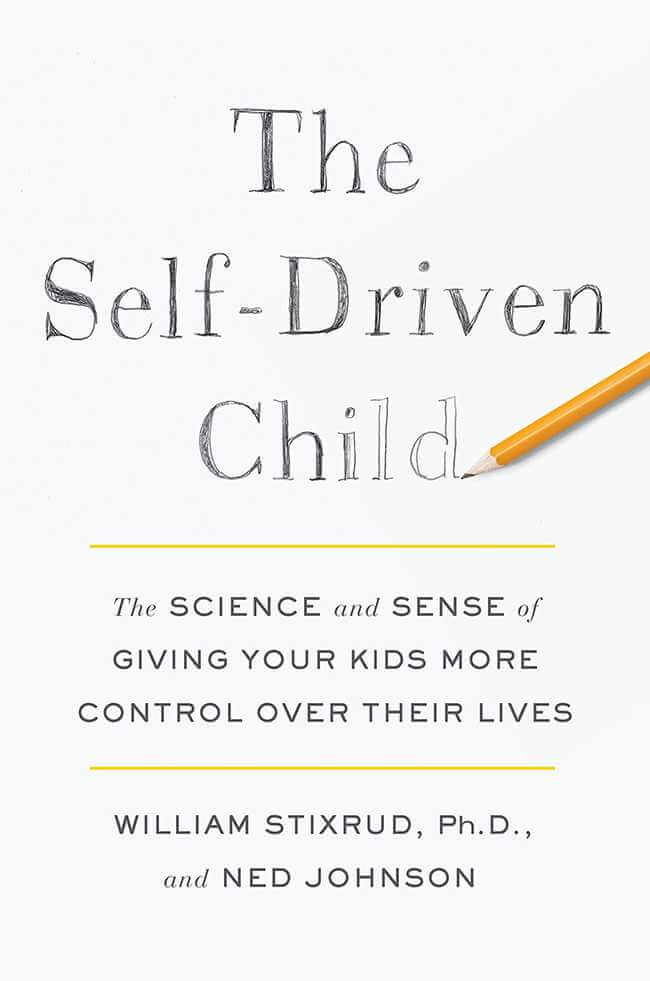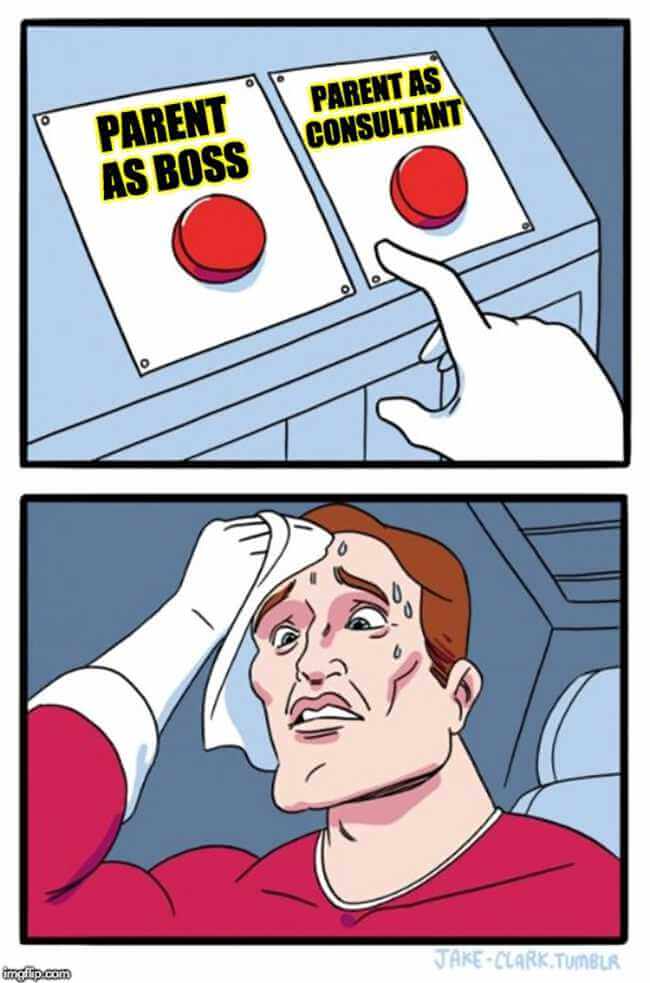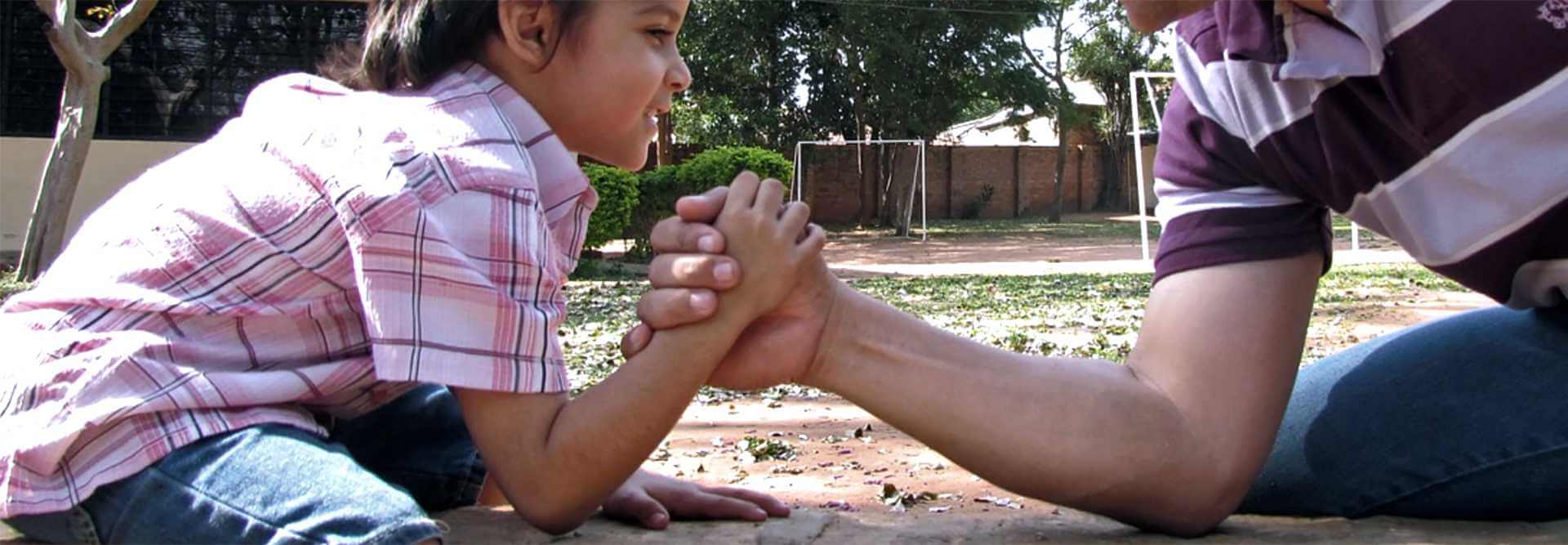What does it take to raise self-directed learners: kids who wants to do stuff, make stuff, and learn stuff on their own, without coercion? Is it rocket science or common sense?
Luckily, we don’t have to guess. There’s already plenty of research that answers this question, neatly compiled in the 2018 book, The Self-Driven Child: The Science and Sense of Giving Your Kids More Control Over Their Lives by William Stixrud, Ph.D. and Ned Johnson.
The Self-Driven Child is packed with powerful anecdotes, practical suggestions, and peer-reviewed studies. It’s a book that I would hand to a skeptical spouse, a teacher dabbling with alternative education, or relatives who doubt the value of giving kids real autonomy.
In this article I summarize and critique the book’s main arguments and share its most relevant conclusions for Self-Directed Education. Enjoy!
Despite All My Rage, I’m Still Just a Rat In a Cage

Shall we begin with an incontrovertible series of arguments about human nature?
- People want to have control over their lives.
- Children are people.
- Children have little control over their lives.
- Therefore, children are stressed.
Stop the presses! Does this mean we should give children more control over their lives?
Alas, if only it were that simple. Today it seems that we need entire books dedicated to this seemingly straightforward proposal. Luckily, The Self-Driven Child does a good job of laying it all out, beginning with a discussion of the basic humans needs for autonomy and control, and how a lack of these creates the modern, over-stressed child.
But wait a second, you might think: Kids today have plenty of control over their lives. They’re the most privileged and coddled generation ever. They don’t have jobs, they hardly do chores, and they’re surrounded by scads of toys and games. Cry me a river: kids today should suck it up, appreciate what they’ve got, and stop whining.
To such a hard-nosed critic we might say: Try walking a mile in a kid’s shoes before assuming that their life is so rosy.
“Lest you doubt how little control children and adolescents [actually have],” the authors Stixrud and Johnson remind us,
...think of what their days are like: they have to sit still in classes they didn’t choose, taught by teachers randomly assigned to them, alongside whatever child happens to be assigned to their class. They have to stand in neat lines, eat on a schedule, and rely on the whims of their teachers for permission to go to the bathroom.
How many parents would put up with the day-to-day existence of the average kid today, even if they got paid for it? Few that I know. Why? Because most kids are powerless, and that’s a terrible feeling:
It is frustrating and stressful to feel powerless, and many kids feel that way all the time. As grown-ups, we sometimes tell our kids that they’re in charge of their own lives, but then we proceed to micromanage their homework, their afterschool activities, and their friendships. Or perhaps we tell them that actually they’re not in charge—we are. Either way, we make them feel powerless, and by doing so, we undermine our relationship with them.
Bravo! What makes this book a pleasure to read is how the authors consistently end up on the side of the child. They’ve clearly spent a lot of time working directly with kids, but not in a conventional role: Stixrud is a clinical neuropsychologist who helps kids with anxiety, learning disabilities, and behavioral problems. Johnson is the founder of a test prep tutoring service who, I assume, has done a ton of one-on-one coaching. Both seem to understand what it’s actually like to be a (schooled) child today, lending a deeper level of credibility to their writing.
The Varieties of Stressful Experience
Okay, so kids today are stressed. Not all stress is bad, of course. To become a successful adult, young people do need to experience some kind of struggle. But what’s the right kind?
Stixrud and Johnson differentiate between three distinct types of stress:
Positive stress “motivates children (and adults) to grow, take risks, and perform at a high level. Think of kids preparing for a play, nervous and a little stressed beforehand, but then filled with a sense of accomplishment and pride afterward.”
Tolerable stress, “which occurs for relatively brief periods, can also build resilience. Critically, there must be supportive adults present, and kids must have time to cope and recover. . . . [An] example of tolerable stress might be an episode of being bullied, so long as it doesn’t last too long, it isn’t repeated too often, and the child is supported by caring adults.”
Toxic stress “is defined as frequent or prolonged activation of the stress system in the absence of support. . . . [Supportive adults] aren’t readily available. The child perceives that he or she has little control over what happens. There seems to be no reprieve, no cavalry coming, no end in sight.”
So yes, Mr. Hard-Nosed Critic, you’re right: kids do benefit from stress as long as it’s the “positive” or “tolerable” variety. But in the authors’ experience, a huge number of kids today are leapfrogging past beneficial stress into the land of chronic, toxic stress.
It’s these kids whose brains become “flooded with hormones that dull higher brain functions and stunt their emotional responses.” Toxic stress, according to Stixrud and Johnson, actually shrinks the parts of the brain that control memory, reasoning, attention, judgment, and emotional control and grows the parts of the brain that lead to anxiety and depression.
Here’s another way to think about it: Have you ever had a really terrible job? A job where no matter how hard you tried, you were never good enough? That’s what a huge number of kids experience every day. They feel overwhelmed and helpless, and they begin to believe: “If nothing I do makes things better, why should I try to do anything at all?” And this is a truly terrible line of reasoning to instill in a young mind—because kids become adults, adults become society, and society shapes all of us.
I’m reminded of a story that John Taylor Gatto tells, of an assistant principal who screamed at an unruly 6-year-old, Bianca, in front of a school assembly: “BIANCA, YOU ANIMAL, SHUT UP!”1
This kind of act must happen thousands of times each day in schools across the country, Gatto surmises. He did a few times himself as a teacher. Yet he (and the assistant principal, and the rest of society) is really just following the directive of the system: to put children in their place.
Then Gatto peers into the future:
...when your little girl Jane, having left her comfortable home, wakes up to a world where Bianca is her enraged meter maid, or the passport clerk Jane counts on for her emergency ticket out of the country, or the strange lady who lives next door.
In my dream I see Bianca as a fiend manufactured by schooling who now regards Jane as a vehicle for vengeance. In a transport of passion she:
- Gives Jane’s car a ticket before the meter runs out.
- Throws away Jane’s passport application after Jane leaves the office.
- Plays heavy metal music through the thin partition which separates Bianca’s apartment from Jane’s while Jane pounds frantically on the wall for relief.
- All the above.
A stressed 6-year-old Bianca, in Gatto’s vision, turns into a hateful and anti-social 40-year-old “fiend” who, having been put in her place one too many times, now exacts her revenge. How we treat children today matters for tomorrow—not just for the individual, but for all of us.
Chronic stress is bad for everyone, and adolescents—those who we pressure the most—already possess exaggerated stress responses. Adolescents’ amygdalae, the authors remind us, are far more reactive than childrens’ or adults’, making them especially susceptible to depression.
All this is to say: Yes, exposing kids to too much stress (of the wrong variety) really is that bad. Kids shouldn’t just “suck it up.” They should feel challenged by positive stress, which typically means: stress that they voluntarily take upon themselves.
So how can a parent inspire their kid to voluntarily accept (or actively seek out) such positive, growth-oriented stress? How do you instill such a drive? The answer begins with a simple but radical shift in perspective.
The Parent as Consultant
Imagine coming home to your spouse each day and hearing something like this:
How was work today? Did you get a good report on your project? You understand how important it is for you to take your work seriously, right? I mean, I know it isn’t always easy or fun, but you really should see if you can get a promotion so you’ll have more options in the future. It just seems like maybe you aren’t doing your best all the time. Like maybe you could work a little harder.
Gag me with a spoon! I wouldn’t wish such a spouse on my worst enemy. Yet this accurately represents the daily conversation that oh-so-many parents have with their kids.
Of course, such conversations come from a place of good intention. Adults think they can see the big picture and kids cannot. No one wants their kids to fail to “apply themselves” and “limit their possibilities.” Parents ride their kids hard—sometimes to the point of tears—because it’s in their best interest—and because that’s your job as a parent, right?
But should we really think of parenting as a job? And does it really make sense to think of school as a kid’s job, either? If it was a real job, after all, they’d get paid to be there.
Every person feels an innate urge to tell others what to do. Each of us has the potential to be a little dictator in our own unique way. Often we can’t get away with being a dictator to our romantic partners, because they might leave us. But kids? They’re dependent on us, so they’re easy pickings. Which makes it easy to see yourself as the boss or manager of your kid’s education and life in general. Yet the more you do this, the more stress you create, and the more resentment and resistance you breed.
Children treated like unpaid sweat-shop laborers for 12 years will not want to take on any sort of challenge. They will not seek out positive stress. They will only want to get away from you and your stupid rules—and perhaps wreck some anti-social havoc on the world, Bianca-style, on their way out the door.
Fortunately, the solution is clear. Stop imagining yourself to be your child’s boss or manager, and start thinking of yourself as their consultant.

The analogy is simple. A good business consultant:
- has more knowledge and expertise than her client.
- helps her client identify the right problem, ask the right questions, and set priorities.
- asks what her client is willing to commit to, or sacrifice, to reach a specific goal.
- doesn’t lose her wits or become emotional when a company fails to reach its targets, because then she becomes part of the problem rather than the solution.
- gives honest advice but never tries to force her client to change... because ultimately it’s the client’s problem, not hers.
“This is my child, not a client,” you might retort. “True,” Stixrud and Johnson reply. “But what’s also true is that it is your child’s life, not yours.” (That’s one of my favorite lines from the book.)
The parent-as-consultant model ameliorates a host of classic parent-child conflicts. Consider homework.
In the boss mindset, you might “find yourself enforcing rules and attitudes you don’t really believe in.” Does it really matter that your 10-year-old memorizes all the state capitals? In boss mode, yes it does—you’re the homework police, no questions asked. In consultant mode, no it doesn’t—you can honestly advise your kid if they want to succeed in the school game, they should probably memorize these capitals in the quickest and least painful way... otherwise, they can simply forget about it. (They can always google them, after all.)
Playing boss can actually incentivize a kid to work less. The authors relate the story of a teenager, Jonah, who had “a tutor, a therapist, and a school counselor who communicated regularly with his parents about his missed assignments.” With all this support, guess how much effort Jonah actually made? None. Because the adults were doing it for him.
The bottom line is, you simply can’t make a kid (especially an older kid) do anything they don’t want to do. As the authors observe, “with homework, if a child truly resists your attempts to get him to work, what are you going to do? Prop his eyes open, move the book in front of his face?”
You know, just like Clockwork Orange?

So how should a consultant-parent help a kid with homework?
Stixrud and Johnson suggest beginning by saying something like this: “Is there anything you’d like help with tonight? I’d like to know, so I can plan my evening.” If you’d like to get more formal, set official parental office hours—for example, 7-8pm each night—when you make yourself fully available to help with homework. If your kid misses the deadline, tell them that you’ll happily help them the next evening at 7pm. If they insist, say “The time for homework has passed. It’s time for bed. You need your rest so you can think clearly tomorrow, and so do I.”
Make a quiet room available to the kid. Offer to help them find a tutor. Show them that you care and truly want to help. And then, crucially, when the homework doesn’t get done, don’t freak out. Don’t intervene with threats and bribes. For heaven’s sake, don’t do the assignment for them. Instead, say something like this: “I won’t act like it’s my job to make you work—because I’ll weaken you if I do.” Then let them fail and suffer the consequences. It’s just homework, after all.
Is this a harsh or neglectful approach to supporting your kid? In fact, Stixrud and Johnson argue, it’s the opposite:
Teachers can teach, coaches can coach, guidance counselors can outline graduation requirements, but there’s one thing only parents can do: love their kids unconditionally and provide them with a safe base at home. For children who are stressed at school or in other parts of their lives, home should be a safe haven, a place to rest and recover. When kids feel that they are deeply loved even when they’re struggling, it builds resilience. Battling your child about due dates and lost work sheets invites school stress to take root at home. So instead of nagging, arguing, and constant reminding, we recommend repeating the mantra, ‘I love you too much to fight with you about your homework.’
The same logic applies to music. Explain why you think playing an instrument is valuable. Tell them that although it’s a lot of work, it’s worth it. Outline the support you’ll give, either personally or via a teacher/tutor/class, and what kind of commitment you expect from your kid. And then make it crystal clear that you won’t fight with him about music lessons because you love him too much to ruin this beautiful thing called music by turning it into a chore.
When you see your kid wavering in his commitment to music, the authors suggest that you offer to sit with him during practice time. Suggest that he take a break from lessons for a few months and see if he misses playing. Tell him that he can always pick up music again when it’s more appealing. Remind him that “most adults don’t play an instrument and that playing an instrument isn’t necessary for music to be an enriching part of one’s life” and that there are “many kids who quit their lessons with their parents’ blessing and later passionately took up the same instrument or another one when they didn’t feel forced.”
In short: Play the long game. Don’t ruin music for your kid by shoving it down their throats.
Regarding athletics, you can take a similar approach to music, but it’s probably not a good idea to push team sports. Instead, try creating a family rule that “everybody does something active” whether that be swimming, rock climbing, martial arts, skateboarding, hiking, fencing, horseback riding, LARPing, or simply messing around outside (i.e., horseplay). There are hundreds of ways to be physically active, and an inactive kid probably just hasn’t found the right fit yet.
The parent-as-consultant wants to raise a self-disciplined kid, not a well-disciplined kid. “Assuming authority over your kids’ responsibilities robs you of quality time and takes away home as a safe base.” Don’t spend the precious time of your kid’s life fighting over homework, music, and sports. Let them make their own decisions, relish their own rewards, and suffer their own consequences. Which brings us to...
How To Actually Be Okay With Your Kid’s Decisions
What does it mean to follow a child’s lead? You’re not talking about relinquishing all control and decision-making power as a parent? That would be insane, right?
Stixrud and Johnson dedicate an entire chapter to this tricky topic, and they strike a good balance:
...when we say we want children and teens to make their own decisions as much as possible, what we really want is for them to make informed decisions. It’s our responsibility as parents to give the information and the perspective that we have—and that they lack—in order to enable them to make the best possible choices.
“It’s your call” does not mean instituting a dictatorship of the young. (“Chocolate cake for dinner every night!”) If your child’s decision doesn’t feel right to you, you have to be honest about it. It’s totally reasonable to sometimes say: “I can’t in good conscience let you make that decision. It doesn’t feel right.” It’s also not about “sneakily getting kids to think a decision is theirs when it’s really yours,” because every kid sniffs out manipulation sooner or later.
Don’t decide things for your kids that they’re capable of deciding for themselves. Do share your knowledge and insights, help them generate multiple possible solutions, make it clear that you’re not going to force your kid to do something they don’t want. And then accept the choice that your child makes—even if it’s not your first choice—reserving your parental veto power for only the most stupid and existentially life-threatening decisions.
Stixrud and Johnson remind us of the old adage: “Wisdom comes from experience, and experience comes from bad decisions.” Like everything, practice makes perfect. Telling your kids about what might happen as a result of their poor decision won’t cut it:
[Kids] need to experience the natural consequences of their choices, ranging from being uncomfortably cold when they decided not to wear a coat, to getting a bad grade on a test because they decided not to study. We commonly see adolescents and young adults go off to college without having had much of an opportunity to make decisions about the things that matter, including how they want to structure their time, what they want to commit their energy to, or whether they want to be in school at all.
At the wilderness camp where I worked for six summers, I helped run a backpacking trip called the “Ascent” in which a group of teenage campers planned and executed their own 3-day, 2-night backcountry adventure. Two adult instructors came along, but we just trailed the group, acting as a sort of insurance policy in case someone got injured or the group became hopelessly lost. We were allowed to talk to the campers and be friendly, but fundamentally, we had a mandate to follow: Don’t solve any problems for the campers. Be invisible. Let them experience what it would be like if you really weren’t there.

On these Ascent trips I spent a mind-boggling amount of time following groups through dense bushes (when a nice granite ridge paralleled our route only a quarter-mile away), watching time go to waste (through hyper-extended lunch breaks), and listening to confused debate over navigational decisions (when the correct route was shockingly obvious). I had to keep my mouth shut, and it was tough. But it could be entertaining, too, like when an Ascent group made a confident route analysis with their map-and-compass and then proceeded to walk in the perfectly opposite direction.
One memory that I especially cherish: An Ascent group once packed everything they needed to prepare a grand feast of macaroni and cheese on the first night. They had the pasta, the stove, the cooking fuel, the cutlery... everything but the cooking pot, which they had forgot to bring as they rushed out the door at 6am.
As the sun set over our high-elevation lake, the teens peered over at me—already toasty in my sleeping bag, boiling up my own pot of macaroni and cheese on my personal cooking equipment—and oh-so-graciously asked if they could borrow my cooking pot after I’d finished dinner.
“Sorry,” I replied. “This is the Ascent.”
No cooking pot for them. It was Clif bars for dinner.
Of the 10-or-so Ascent trips I staffed, I perhaps only intervened three or four times, none of which involved a true threat to life or limb. Did I let the campers waste time, argue needlessly, get scraped up by unnecessary bushwhacking, or deal with temporary hunger? Yes. When they returned to camp after three days, did they resent me for it? No. They were too busy being overjoyed with a newfound sense of freedom and accomplishment from completing their first “solo” backpacking trip in the mountains! (I was so impressed by the Ascent that I integrated the approach on my Unschool Adventures trips, empowering small groups of teenage unschoolers to wander around foreign cities on their own, with overwhelmingly positive results.)
Is the Ascent trip—and its corresponding philosophy—something that’s only fit for highly talented and exceptionally experienced teeangers? Maybe. But we’d do well to remember that, from the dawn of time until just about a hundred years ago (in developed countries, less elsewhere), adolescents have made big decisions for themselves and held serious responsibilities. They grew up working on family farms, working for other people’s businesses, raising siblings, piloting vehicles, caring for animals, and sometimes marrying and having their own children.
Yes, we have extended adolescence, and we cannot expect the same of a 15-year-old today as we might one of the 18th century. But given an authentic opportunity to prove themselves, in a situation that they freely elect, with the loving support of parents and other adults, I believe that young people can surprise us.

Okay, back to The Self-Driven Child. Digging up some evidence for their claims, Stixrud and Johnson cite a study that looked at decision-making capabilities of people age 9-21:
The study asked the participants how they would handle a really sensitive situation: a boy who refused to talk to family members or come out of his room for several weeks. Turns out, fourteen-year-olds made decisions that were very similar to those of eighteen-year-olds and twenty-one-year-olds. And those decisions resembled the recommendation made by most experts (which was that the boy get outpatient psychotherapy). Interestingly, half of the nine-year-olds chose that option, too. Overall, the fourteen-, eighteen-, and twenty-one-year-olds got virtually identical scores on decision making, and the nine-year-olds’ scores were only slightly lower.
Another study shows that “by the time kids are fourteen or fifteen, they generally have adult-level ability to make rational decisions,” a fact corroborated by those millennia of responsible adolescents. (It’s also true that their brains aren’t fully developed at age 15—but that retort can only go so far.)
The authors go on to provide helpful, concrete examples of how to welcome the decisions of kids of all ages, from toddlers to college students, and tackle common questions and answers with incisive common sense. One response I particularly appreciated:
Q: “In the real world, kids don’t get to make all their own decisions. Don’t we need to prepare them for being told what to do and then doing it responsibly?”
A: “You’re right, there are plenty of circumstances in which kids (and adults) don’t get to make their own decisions. But the equation here works differently than you might think. Giving kids more choice when you can makes it easier for them to accept authority when they need to.”
I’ve seen that logic play out, over and over again, with unschoolers and alternative-school students who decide to enter a highly traditional university or workplace. Despite their free-choice upbringing, such young adults can still play well with authorities—perhaps because they weren’t scarred by illegitimate authority as children.
The Self-Driven Child does a stellar job of easing parents—especially those with conventional or authoritarian backgrounds—into the logic of listening to children. But it’s not just about relaxing your grip on your kids, they acknowledge, it’s about dealing with your own issues, too.
Be a Non-Anxious Presence
Stixrud and Johnson cite a recent study, finding that:
...other than showing your child love and affection, managing your own stress is the best thing you can do to be an effective parent.
Shall we file this in the Department of Obvious But Tricky Truths?
Anxious parents breed anxious children, both genetically (it runs in the family) and through the home environment they foster. It doesn’t help that kids are “great observers but lousy interpreters”:
...an adult might spend the evening in the company of her grumpy spouse and think, ‘He’s grumpy, but it’s not about me. I think I’ll just leave him be,’ a kid is likely to think, ‘Dad is grumpy. I must have done something wrong. He’s mad at me.’
Parents with unmanaged anxiety create destructive cycles of behavior with their kids. You worry, you control, they rebel, you worry more, your need for control increases... and they rebel further.
In addition to the standard recommendation of working with a therapist, The Self-Driven Child recommends that highly anxious parents focus on two big parenting principles:
- Make your home a safe base for kids. “When your home is a calm space, free of excessive fighting, anxiety, and pressure, it becomes the place to regenerate that your kids need. . . [remember] that it’s your child’s life, not yours, and that his problems are his problems, not yours. It’s easier to adopt this philosophy when we’re calm, and it’s easier to be calm when we adopt this philosophy.”
- Make enjoying your kids your top parenting priority. “You don’t have to spend every moment with your kid, or convince yourself parenting isn’t hard when it is. But think for a moment about the giddy look we give babies when we see them in the morning or after a long day away. Think about the experience of being that baby: every time someone looks at you, they smile as if you’re a miracle. Your kid needs to feel the joy of seeing your face light up when you see him because you are genuinely happy to spend time with him.”2
According to a survey in the late 90s, what children and teens want most for their parents—more than actually spending time with them—is for parents to be happier and less stressed.
Give the kids what they want. Quit the boss role. If you’re chronically anxious about your kid, try scheduling a regular block of time in your calendar to worry about your kid, so at least you won’t do it all day long. Do what you must to adopt an attitude of nonjudgmental acceptance.
The Secret Sauce of Self-Motivation
Daniel Pink introduced me to intrinsic motivation in his 2009 book, Drive, and I still recommend that book for diving into the science of self-motivation—but The Self-Driven Child nips at its heels. Watch out, Pink!
Stixrud and Johnson boil down all the major theories of self-motivation into one short chapter, beginning with a discussion of the (occasional) necessity and virtue of extrinsic motivators: sticks and carrots, threats and bribes.
There are some things we need our kids to do simply because we need them to get done. . . . Rewards can be effective and in some cases can even spark good habits. They can help encourage your kids to accomplish short-term goals, to modify behavior, and to ensure cooperation. . . . For some kids, especially kids with ADHD, rewards can get the brain to activate for boring tasks, and can help them buckle down to do tasks that are really hard for them to do, like going to bed on time or doing their homework. But these scenarios are not about developing motivation—they’re about enlisting cooperation.
That last sentence is crucial. Motivating your kids to brush their teeth, buckle their seat belts, or keep quiet in the movie theater isn’t the same as helping them motivate themselves. In the long run, threats and bribes kill creativity, incentivize cheating, and “reinforce the idea that someone other than the child is responsible for his life.”
So what goes into the secret sauce of self-motivation, and how can you use this to convince a skeptical spouse, friend, or relative that you’re not crazy to give your kids genuine autonomy?
Stixrud and Johnson review three motivational frameworks, each backed by decades of research: Mindset, Self-Determination Theory, and Flow.
Mindset, the brain-child of Stanford researcher Carol Dweck, argues that intelligence is earned through practice, not fixed at birth. Thus, parents and educators should praise children’s efforts, not their abilities. Not without its flaws, mindset offers an important starting place for parents coming from conventional backgrounds.
Self-determination theory, created in the 70’s by psychologists Richard Ryan and Edward Deci, proposes that all humans have a basic need for autonomy (freedom of choice), competence (the development of mastery), and relatedness (the feeling of being connected to others and cared about). When these elements are present, people can act out of genuine intrinsic motivations. Without these elements, they must be “motivated” with sticks and carrots—which is appropriate for boring little tasks (like brushing your teeth) but turns destructive when done too often or too long. Self-determination theory, in my opinion, is the most powerful way to convince a skeptical parent to begin changing their tune about coercive education.
Finally, that guy with that seemingly impossible name, Mihaly Csikszentmihalyi, created the theory of “flow.” (It’s not actually so hard to pronounce.) Flow describes a state of total engagement where you’re challenged to perform at your absolute peak. Skeptical parents can typically relate to flow through a personal experience with sports, music, their job, or the outdoors. Then you, the provocateur, can say: “Yup, that’s what our kid is doing when they’re playing computer games.” Boom!
For the brief moment their guard is down, follow up with this quote from The Self-Driven Child:
So when you see an eight-year-old highly focused on building a Lego castle, lips pressed in concentration, what she is actually doing is getting her brain used to being motivated. She is conditioning her brain to associate intense enjoyment with highly focused attention, practice, and hard work. Just as frequent exposure to high levels of stress can sculpt a young brain in ways that are unhealthy, frequent exposure to states of flow can sculpt a young brain to be motivated and focused. . . [It’s] also true for a fifteen-year-old who may struggle in school but is passionate about skiing, or drawing, or playing an instrument. The best way to motivate him for the things you think he should focus on is to let him spend time on the things he wants to focus on.
This is the long-term value of letting kids become “obsessed” with activities where they’re clearly in a flow state: it empowers them to put “the pedal to the metal” in later workplaces, formal academic settings, or personal hobbies.
Flow is also highly rewarding in and of itself. That’s why, when you empower your kid to engage in flow activities (even seemingly addictive video games), you do her a great service both now and in the future.

In the chapter-end FAQ, Stixrud and Johnson tackle tough retorts to this line reasoning, including the inevitable “My kid isn’t motivated to do anything” question and “My kid is a chronic homebody” concern. They respond with fair advice and, thankfully, steer clear of the fundamentalism about motivation that is sometimes espoused in the Self-Directed Education community.
Ultimately, the authors advise parents to give kids “as much control over their choices as possible, including asking them what it is they want to be competent at and in charge of.” Well said.
At this point in the book, you think that the authors would come out as rabid critics of conventional school, which is essentially the poster child for extrinsic motivation. Unfortunately, not so much.
School Daze
“We see a lot of kids who hate school. Not coincidentally, a student’s sense of control lowers with every year they attend.”
Yup!
“They transition from lots of free choice in the youngest grades to mandatory homework, standing in line, having to ask permission to use the bathroom, and needing to do what’s asked, exactly as it’s asked, almost every moment of the day. Where is the autonomy there?”
Yup!
“From preschool through to college, we want kids to have a school experience that is engaging, and inventive. School should provide a mixture of stimulation and downtime. It should encourage kids’ natural curiosity and allow them to be in a state of flow for long periods of the day.”
Yup!
So what’s your recommendation, guys? You’ve seen lots of kids damaged by school. You acknowledge it’s a broken system. You’ve reviewed the literature. What we should do?
This is where The Self-Driven Child disappointed me... wildly.
Joining the club of researchers and educators who seem desperate not to upset their friends in public education, Stixrud and Johnson offer trite, generic, and toothless solutions to families whose kids are suffering in school:
- Give your kid autonomy outside of school
- Encourage teachers to give their students choices, seek student feedback, and explain the reasons behind assignments
- Help your kids connect with his teacher or talk to the principal about switching teachers
What really got me going, though, was reading this piece of advice:
...the most effective thing you can do is to emphasize to your child that he is responsible for his own education.
Give. Me. A. Break.
While I fundamentally agree with the idea, it doesn’t hold water unless accompanied by the idea of making education consensual. Grace Llewellyn framed it best in The Teenage Liberation Handbook:
Schoolpeople justify their actions by saying they’re teaching you to be responsible and ‘follow through’ later in school and later in life. But all of this is so different from ‘real life’ that it’s ridiculous. In ‘real life,’ you choose what to take responsibility for. Under circumstances of freedom, following through is a completely different game from the one you play in school.
The rest of the school-oriented chapter in The Self-Driven Child reads a lot like an advertisement for a democratic free school or self-directed learning center:
Students learn and perform best in an environment that offers high challenge and low threat—when they’re given difficult material in a learning environment in which it is safe to explore, make mistakes, and take the time they need to learn and produce good work. When students know it’s all right to fail, they can take the kinds of risks that lead to real growth.
The authors continue to bash conventional schooling while never taking the logical next step of recommending that families seek true alternatives:
Many of the kids we see aren’t learning in this environment. They’re learning in a brain-toxic environment, where their days consist of stress and fatigue, often accompanied by high levels of boredom. You know that classical description of war as ‘interminable boredom punctuated by moments of terror’? Many schools have become pastel versions of this.
Stixrud and Johnson advise struggling families to create “stress-reduction teams that include students, teachers, administrators, and parents—with the goal of exploring ways to make school less stressful for everyone. . . . These teams can focus on ways of increasing student and teacher autonomy, creating more opportunities for downtime during the school day, and modifying homework policy (like removing homework requirements during vacations).”
Sorry guys, but your heads are in the clouds. This is not going to happen. Why not take your own medicine and promote homeschooling, unschooling, alternative schools, and teen self-directed learning centers—the kind of approaches that actually embrace the research and parenting philosophy you cite in the rest of the book?
Maybe you do believe in this really alternative stuff, and your publisher forced you to remove it from the manuscript. I don’t know. It just doesn’t make sense. The rest of the book is pure gold; this chapter is confusion and contradiction.
In a final desperate volley, the authors encourage families to talk through the pros and cons of simply not doing homework. “Which is more important? [Your kid’s] happiness and well-being, or his grade with this particular teacher? To us, the answer is clear.”
Agreed. Now apply the same logic to conventional education as a whole. The answer is clear.
To College or Not To College
The second half of The Self-Driven Child tackles a smorgasbord of topics, offering advice on topics that you’ve likely encountered elsewhere:
- meditation (do it)
- sleep (prioritize it)
- screen time (essentially the same as Jean Twenge’s advice)
- learning disabilities
They tackle common parenting issues including religion, sports, music, teenage drinking, perfectionism, and mental health... and while these are all fine and good, they’re not the most interesting parts of the book.
Fortunately two jewels are buried near the end, starting with an excellent chapter on when (and whether) young adults should attend college.
First of all, we all need to chill out about college. Stixrud and Johnson remind us that 4-year college really doesn’t have to start (and sometimes really shouldn’t start) at age 18:
There are many reasons why adolescents might not be ready to go to college right after high school. They may lack the adequate academic skills. They may lack self-awareness or self-regulation skills, or struggle with anxiety or depression. They may not be ready to manage the details of living independently. Or they may be burned out from four years of going pedal to the metal in high school. They may be prone to social isolation. Or their brains simply may not be developed enough.
Did your kid initiate his own college search? Did he complete his own application and essay, and did he independently seek help if he struggled with them? If so, then he’s probably ready for college. If not, then he probably doesn’t possess the appropriate combination of self-understanding, self-regulation, self-motivation, independent living skills, social competence, stress management skills, and academic preparation
How might a young person build such a variety of skills? By taking a gap year, of course! I was delighted to read their full-fledged endorsement of the concept of gap years.
Young people: go travel, work, volunteer, see the world, get uncomfortable (think: positive stress), make friends, start a business, make art, read books, get curious, and do everything else that you were prevented from doing in school. Then, maybe, you’ll be ready for college.
Parents: if you feel skeptical about funding your kid’s rush into college—often to the tune of $10,000+ per year—then seriously consider funding their gap year. Because while your kid can apply for college loans, grants, and scholarships on her own, she probably can’t bankroll $1000/month (give or take) for independent living and travel expenses at age 18.
Young people who take gap years are better prepared for college, which means that your future investment in college (or your kid’s future debt burden) will be better spent.
What Really Matters
What if your kid has no interest in college? What if they want to go to a weird alternative college? What if they just want to do their own thing, stringing together multiple gap years into a gap life?
Stixrud and Johnson conclude their book with an inspiring chapter on “alternative paths” to success, in which they profile a wide variety of people—from dropouts to Ph.D.s—illustrating how the straight-and-narrow route is not for everyone.
Stixrud himself got a 2.8 GPA in high school, flunked out of an English Ph.D. program, went back to graduate school to become a teacher, taught for a year (and hated it), and changed course again to become a psychologist... which he stuck with for 43 years. Flunking out of that English Ph.D. program, he said, was the “best thing that could have happened.”
What matters most isn’t where you go to school, or whether you go to school at all:
The reality is that we become successful in this world by working hard at something that comes easily to us and that engages us. We need to tell our kids that the skill set required to be a successful student is, in many ways, very different from the skill set that will lead you to have a successful career and a good life.
At the end of the day, despite its failure to acknowledge the many alternatives to conventional school, The Self-Driven Child delivers a powerful, science-based critique of the standard model of parenting and education, accompanied by practical guidance and solutions. Its final message: life is long and full of opportunity. You don’t have to be conventionally smart to succeed— “you only have to be smart enough to do something interesting in this world.” I wholeheartedly agree.
[1] Gatto, John Taylor, et al. The Underground History of American Education: An Intimate Investigation Into the Prison of Modern Schooling. Volume I. Oxford Scholars Press, 2006.
[2] On the flip side of the coin, for those who spend lots of time around their kids: “...perhaps you’re not enjoying your kids because you’re spending too much time with them.”
If you enjoyed this article and feel called to give back to ASDE, here are ways you can support our work:
- Donate money
- Share our content with others! Click one of the buttons above to easily share on Twitter, Facebook, or email.
- Consider becoming a Contributor for Tipping Points
Tipping Points Magazine amplifies the diverse voices within the Self-Directed Education movement. The views expressed in our content belong solely to the author(s). The Alliance for Self-Directed Education disclaims responsibility for any interpretation or application of the information provided. Engage in dialogue by reaching out to the author(s) directly.






